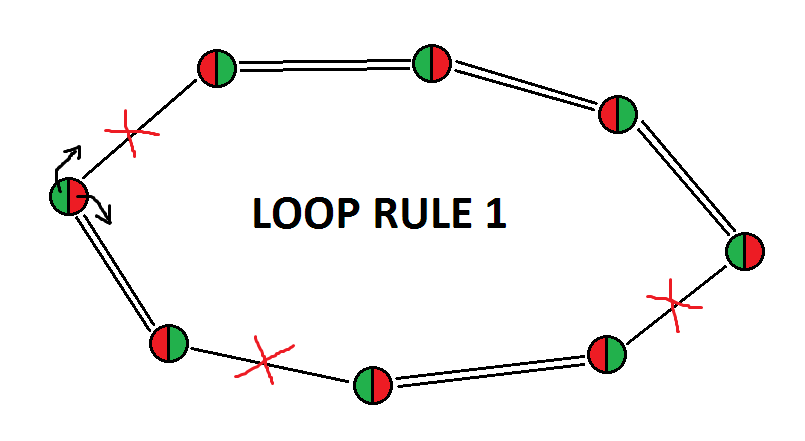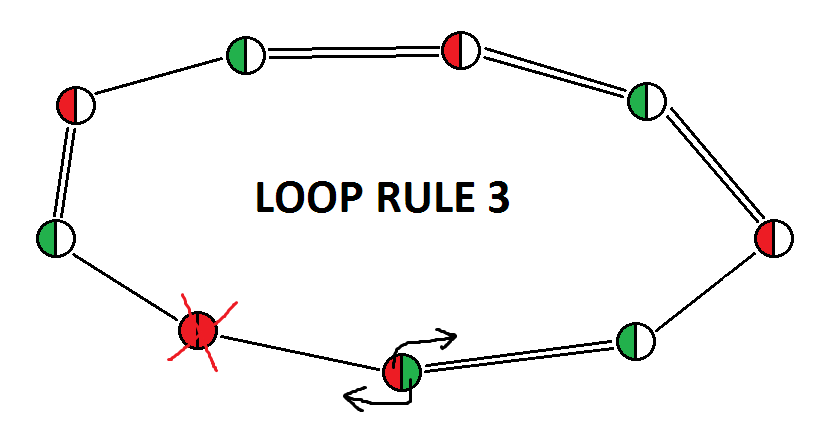jco wrote:Hi,
I just would like to show the problem with
this plot.
[...]
N not being at r1c7 does not imply that N must be at r1c13.
Hi,
I know, and in fact I have never said anything like that!

The logical inferences you listed show that if r1c13 is false then r1c7 is false, if instead r1c13 is true then r1c7 is false, so that loop I drew tells us that we can eliminate the candidate in r1c7, since it is false in both cases.
-----------------------------------------------------------------------------------------------------------------------------------------------------------------------------------------------------------------
Cenoman wrote:I have tried to understand why our messages are still misunderstood. So I have read again X-Cycles articles, grouped X-Cycles and ER articles. I feared they were confusing, but that is not.
In fact, the SudokuWiki site has nothing to do with it, as previously mentioned:
Mino21 wrote:it is true that I read something on SudokuWiki, but through the reasoning I tried to give myself an explanation, on which I then based the implementation of x-cycles in C++
Cenoman wrote:But if you set this as a requirement you will miss all the X-Cycles with x in the mini-column r456c32
- Code: Select all
+---------------+---------------+---------------+
| x x x | | x |
| x | x | x |
| x | x | x |
+---------------+---------------+---------------+
| x x | | x |
| x | | |
| x x | | x |
+---------------+---------------+---------------+
| | | |
| x | | x |
| x x | | x x |
+---------------+---------------+---------------+
Written as an X-Cycle
(x): r1c7 - r1c13 = r123c2 - r8c2 = r9c13 - r9c9 = r4c9 - r1c7
Written as an AIC (my preference, of course) (x): r1c13 = r123c2 - r8c2 = r9c13 - r9c9 = r4c9 => r1c7<>x
I know it's just an example, but I believe that the candidates configuration is not valid (and in the chain I think you wrote r4c9 instead of r3c9).
Anyway, assuming I'm not sure I understand what you mean, I really don't understand why my algorithm shouldn't be able to find the cycle you just reported?!
-----------------------------------------------------------------------------------------------------------------------------------------------------------------------------------------------------------------
StrmCkr wrote:too wordy here's the dipiction that won't work
- Code: Select all
| X X X | / / / | / X / |
| / X / | . . . | . . . |
| / X / | . . . | . . . |
-----------------
| . / . | . . . | . . . |
| . / . | . . . | . . . |
| . / . | . . . | . . . |
-----------------
| . / . | . . . | . . . |
| . X . | . . . | . -x . |
| . / . | . . . | . . . |
-----------------
Finally, maybe this time I'll understand why I'm wrong!

In this case with my approach I would get the following two chains:
r1c123=r1c8-r8c8-r8c2-r23c2=r1c123
r123c2=r8c2-r8c8-r1c8-r1c13=r123c2
that are both not valid loop cause they have three consecutive weak links.
instead I seem to understand that with your official approach you get a valid loop that allows an elimination in r8c8, rigth? And what exactly would this cycle be?






